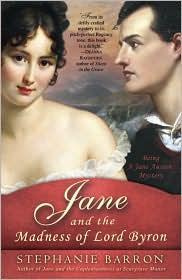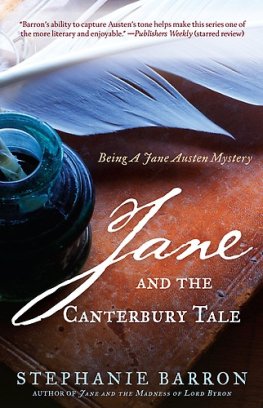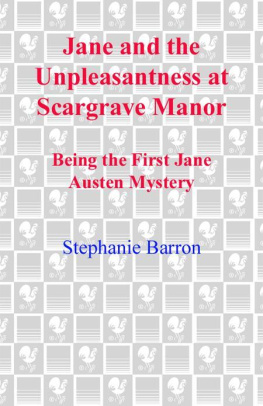Annotation
If Jane Austen really did have the 'nameless and dateless' romance with a clergyman that some scholars claim, she couldn't have met her swain under more heart-throbbing circumstances than those described by Stephanie Barron.
Stephanie Barron
Jane and the Man of the Cloth
Being the Second Jane Austen Mystery
Dedicated with love to my sister Cathy,
who always gave me the best books;
and to my sister Jo,
who taught me to read
Editor's foreword
When Jane Austen traveled to the Dorset coastal town of Lyme Regis in the late summer of 1804, she returned to a part of England she had first visited the previous year and that she is thought to have loved. She chose Lyme and its peculiar blend of fishermen, retired naval officers, and fashionable pleasure seekers for a pivotal passage in her final novel, Persuasion, published posthumously in 1818. Her affection for the town's steep streets and bracing Cobb (a stone breakwater encircling the harbor of the same name), the secretive wilderness called the Pinny and the high downs beyond, shines through the scenes she set down on paper over ten years after the action of this memoir.
For Jane and the Man of the Cloth is exactly that -- a memoir of Austen's detective adventures in Lyme in the late summer of 1804. Austen scholars have long been frustrated by their lack of knowledge about this period in her life, since only one letter written from the town survives in the collected correspondence. In that lengthy note to Cassandra, Jane talks of many people and events that will become familiar to the reader of the present volume. We listen as she discusses Mr. Crawford, with whom she had danced the previous evening at the Thursday night Assembly; the servant-man James and his lanthorn; Miss Armstrong; the Schuylers and the Honourable Barnewalis--"bold, queer-looking people, just fit to be Quality at Lyme"--and the mysterious man she names only as Le Chevalier, who divided the winnings of a card game with her mother. The details are tantalizing, because they are fragmentary -- and yet powerfully suggestive of the richness of the author's visit to the Dorset coast.
At long last, the full story of Jane's extraordinary Lyme experiences may be shared with the world, in the form of this diary account, one of many discovered among the long-lost Austen journals currently undergoing restoration and editing in the United States.
Although the events Jane Austen describes in the following pages are surprising enough, it is possible that they serve to elucidate a personal episode in her life that has been the subject of much conjecture and debate. Years after Jane's death, Cassandra Austen, Jane's older sister and closest confidante, told her niece Caroline that the writer was involved in an unfortunate love affair with a clergyman whom she had met during a seaside holiday. The young man died or otherwise disappeared before an engagement could be formed, and since Cassandra was notoriously closemouthed regarding her sister's private life, neither the gendeman's name nor the exact history of the affair have come down to posterity. Various Austen family members recorded conflicting explanations of the episode -- which Caroline Austen termed Jane's "nameless and dateless*' romance -- and the facts appear to have been garbled with time. It has been suggested that the clergyman's brother was a doctor, whom Cassandra visited years after Jane's death; or that the unknown suitor was in fact the Reverend Samuel Blackall, an acquaintance of Jane's for many years previous to this period. Constance Pilgrim, in her book Dear Jane: A Biographical Study of Jane Austen (Pentlands Press, Durham, 1971), goes so far as to suggest that the writer's mystery lover was Captain John Wordsworth, a naval officer and brother of the poet William Wordsworth, who was lost with his ship in 1805, and that they met in Lyme Regis as early as 1797--a theory described as "fanciful" by George Holbert Tucker, another Austen scholar. Some have asserted that Jane met the unknown clergyman while traveling with her family in Dorset during the summer of 1801; others place the encounter closer to 1804.
Jane and the Man of the Cloth offers one possible answer to the debate. Austen's acquaintance with both Geoffrey Sidmouth, whom she believed to be the notorious Reverend, and Captain Percival Fielding -- as well as Sidmouth's friendship with the medical doctor William Dagliesh, whom Cassandra knew and might well have visited in later years -- make it likely that the writer's "nameless and dateless" romance occurred in Lyme in the late summer of 1804. To offer further evidence here would be to spoil the tale for the reader; so I shall allow Jane to speak for herself and leave it to the reader to determine the truth of matters.
In editing this volume, I found that Geoffrey Morley's 1983 work, Smuggling in Hampshire and Dorset: 1800--1850 (Newbury UK: Countryside Books), was very nearly indispensable. I would offer it to readers who wish to know more about Free Trade and the Gentlemen of the Night. Novelist John Fowles, who has lived and worked in Lyme for many years, is the author of A Short History of Lyme Regis (Little, Brown & Co., 1982), a concise but thorough summary of the town and its past.
STEPHANIE BARRON
EVERGREEN, COLORADO
Chapter 1
The Perils of Travelling Post
3 September 1804
at High Down Grange,
on the Lyme road
IT IS A TRUTH UNIVERSALLY ACKNOWLEDGED, THAT THE EXPECTATION of pleasure is generally preferred to its eventual attainment -- the attainment being marred, at its close, by the resumption of quotidian routine made onerous by the very diversions so lately enjoyed. But as I gaze upon the tortured aspect of my dearest sister, her head bound round in a makeshift bandage, her pallor extreme, and her features overlaid with suffering, I must declare all such nice distinctions the indulgence of a frivolous mind. For how much more melancholy still, to find pleasure usurped entirely by the advent of disaster! To have no chance of mourning the end of good times, by observing them waylaid and truly routed before they had even begun! And Cassandra's is the sort of misfortune one never anticipates, being met in unhappy accident -- the chance of a moment decided it; and the course of our long-awaited pleasure trip to Lyme is thrown utterly to the winds.
But I write entirely of outcomes, and am quite heedless of causes; a testament to the discomposure of my mind. I shall step back, the better to govern the tumult of my reason, and endure again the horror of those moments that left my dear one insensible in a stranger's bed.
BATH BEING UNBEARABLY HOT THIS AUGUST, AND MY FATHER'S health indifferent, we determined to exchange our rooms in Town for more salubrious ones along the coast. We had little inclination to try the bustle and vulgarity of Ramsgate, and even more frequent dances in the town's pretty little Assembly Rooms; our memories of the place were so cheerful, in fact, that the plan met with immediate approval. Bath was forgotten; Ramsgate consigned to those of little sense or taste; and Lyme became the object of all our fondest hopes.
Being possessed of a fortune that no longer admits of a private carriage, but finding ourselves above the meaner conveyance of mail coach and stage -- the former being adjudged too swift and precarious for my father's temper, and the latter too crowded and vulgar for my mother's-- we were forced to adopt the only alternative, a post chaise initiating in Bath, with horses changed daily















